The South American country of Colombia is a popular destination for those that want to explore its tropical landscapes and fascinating, vibrant culture. Over six million people visit the country each year.
Colombia’s vibrant cities such as Cartagena and Medellin attract the most visitors. Colorful Cartagena has a well-preserved Old Town dating to the colonial era, a rich musical culture, and great restaurants.
In the countryside, you can explore Colombia’s spectacular nature, such as Tayrona National Park on the Caribbean coast or the spectacular Cocora Valley nestled in the jungle highlands. For visitors, Colombia’s vibrancy and the warmth of its people make any trip one to remember.
But while there’s countless things to see and do in this country that’s rich in culture and history, is Colombia safe to visit? Here’s our take.
Is Colombia Safe to Visit in 2024?
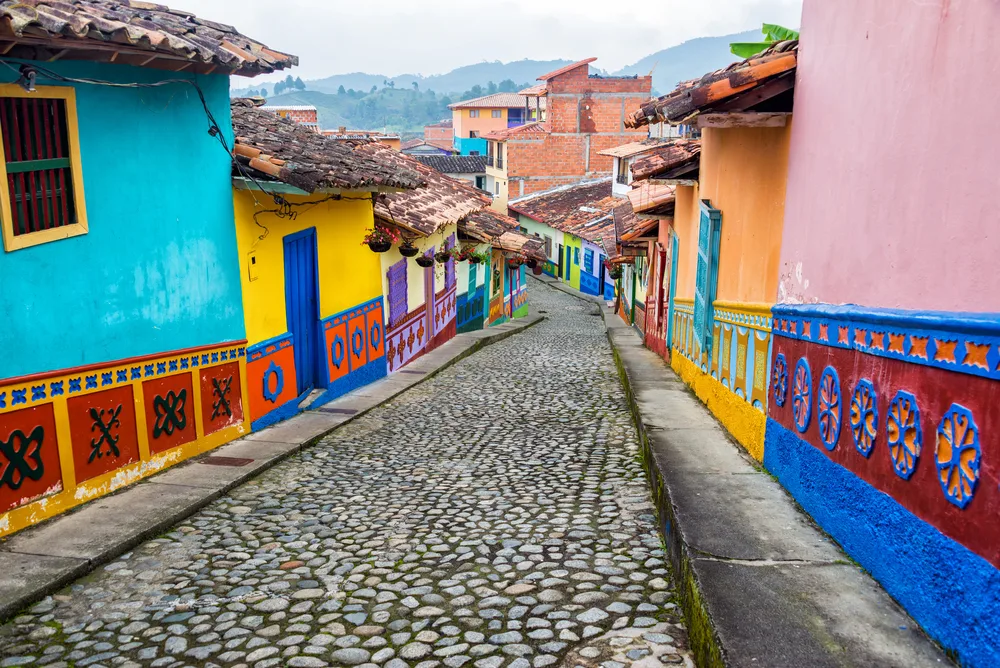
Jess Kraft/Shutterstock
Yes and no. You’ll need to be on your guard at all times, although it is possible to travel to Colombia safely. There is a high risk of violent crime, terrorism, and civil unrest throughout the country.
Some parts of the country should be avoided altogether due to their risk. Most countries issue travel advisories that urge some caution when visiting Colombia. The United States State Department advises its citizens to reconsider travel in a Level Three out of Four travel advisory.
It cites the risk of crime, terrorism, and violent civil unrest as the reasons why potential visitors should think twice before heading towards Colombia. Other countries are a bit more relaxed when it comes to their travel advisories for Colombia, but still exercise some degree of caution.
For example, the Australian government places Colombia under a Level Two out of Four travel advisory, advising citizens to exercise increased caution in the country as a whole and avoid certain regions altogether.
The most common problems mentioned in travel advisories for Colombia include:
- Kidnapping
- Armed robbery
- Violent crime, including homicide
- Civil unrest
- Violent protests
- Terrorism
To understand why Colombia struggles so much with security, it helps to know a bit about the local political and historical context. Colombia has been suffering from a low-grade civil war ever since the 1960s.
The lawless atmosphere created by the conflict and the presence of many paramilitary groups created an atmosphere where drug trafficking thrived. To this day, the drug trade is a major source of violence in the country (as people who have watched the TV series Narcos about the notorious Pablo Escobar may know).
Some progress towards peace was made in 2016 when the government and the largest guerrilla group, the FARC, signed a peace treaty. However, the agreement has been difficult to implement, especially in more remote areas.
Violence is still ongoing in more remote regions such as Putumayo and there are parts of the country where the state is still struggling to exercise control.
Against the background of such conflict, it makes sense that politics in Colombia is still a highly contested sphere. Massive demonstrations are still common throughout the polarized country and can turn violent.
Political leaders and activists are often assassinated. While in Colombia, try to avoid taking political stances and definitely avoid any demonstrations or other political actions.
Entities such as the U.S. Embassy in Colombia usually issue alerts advising visitors and residents when a demonstration is planned so they can avoid the area. Crime may grab the headlines, but visitors should also be wary of other risks — those coming from nature.
Colombia is vulnerable to many natural disasters, including:
- Earthquakes
- Landslides
- Flooding
- Hurricanes
During the rainy season, heavy rain often causes landslides and flooding that have deadly consequences, especially in more remote parts of the country. Colombia is not as affected by hurricanes as other parts of the Caribbean, since it is located further south from the Hurricane Belt, but hurricane season still brings heavy rain.
If you are visiting during the rainy season, make sure that you check weather advisories, especially if you are venturing into the countryside where there is a higher risk of landslides.
Ready to Book?
Unlock Exclusive Discounts on Expedia.com!
Got Travel Insurance?
Protect yourself for unexpected interruptions.
Compare Plans We may be compensated when you book after clicking on one of our links.Crime in Colombia
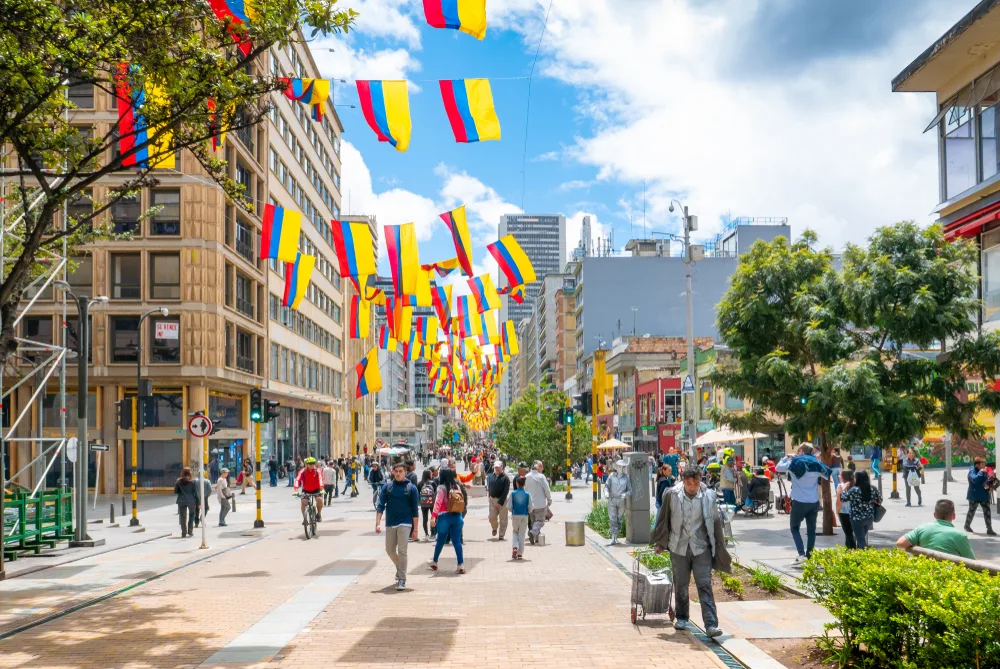
Bogota Colombia August 6 The Seventh street in the center of Bogota is full of life and every day there is a an event to celebrate. Shoot on August 6, 2019/Mark Pitt Images/Shutterstock
Crime is usually one of the primary concerns for visitors to Colombia, and with good reason. The country has a very high crime rate — one of the highest in the world. The crime rate is driven by the ongoing armed conflict and the presence of many narcotrafficking groups.
What is particularly concerning is the high rate of violent crime in Colombia. The homicide rate in Colombia is a whopping 27.48 incidents per 100,000 people.
That makes Colombia the country with the 12th highest homicide rate in the world. A high homicide rate is usually indicative of a high rate of other violent crimes, and that is true for Colombia as well.
According to the Organized Crime Index, Colombia has a high rate of other crimes, including human trafficking, extortion, and armed robbery. Women are also at a high risk of sexual violence.
Many of these crimes are perpetrated by international crime syndicates and drug traffickers, as Colombia is the world’s top producer and trafficker of cocaine. It is a mistake to think that violent crimes perpetrated by these groups are targeted.
Civilians are often caught in the crossfire of gang wars, or attacked and robbed by criminals affiliated with gangs. Besides violent crime, Colombians are very concerned about other forms of crime as well. Statistically, the most common crime is theft, and petty street crimes are omnipresent in the country.
32% of Colombians are very concerned about crime and violence, seeing it as the main problem in their country. These statistics paint a sobering picture of crime, which is still a very real problem that affects locals and visitors alike.
If anything, visitors are slightly more protected than locals because crime rates are lower in wealthier neighborhoods where tourists tend to visit and stay, and police tend to be more responsive to tourists.
However, there are some positive signals from Colombia in terms of crime. In 2022, the government implemented a new “Total Peace” plan that was supposed to make the country safer. The project had mixed results, but hopefully it can continue taking steps towards a safer future.
Armed Robbery
One of the most common crimes that tourists are victims of in Colombia is robbery, including its most violent form, armed robbery. The United Kingdom warns its citizens about the risk of armed robbery in its travel advisory.
Tourists are often targeted and street robbers operate in areas where they know tourists tend to venture as well as more impoverished areas of the city.
Tourists are usually targeted after they withdraw money or if they seem inebriated, but anyone could potentially be a victim of armed robbery. People have also been kidnapped or express-kidnapped (meaning that they are held at gunpoint while they drain their bank accounts at the ATM).
Avoid anything that may make you seem like a likely target to potential robbers. Avoid walking alone pretty much anywhere, especially at night (hikers have even been robbed at gunpoint on remote trails).
Don’t wear expensive jewelry or take out large amounts of cash. Don’t use ATMs at night. At night, travel via reputable taxi services, including those from apps such as Uber, DiDi, and Cabify, and always check the license plates of your rideshare before getting in.
The Australian government warns that some robbers use date rape drugs such as scopolamine to incapacitate their victims. Never, ever leave your food or drinks unattended while you are in Colombia.
Attractive people you meet will sometimes be criminals in disguise, so be cautious if someone seems too interested in you at the bar or if you meet someone through a dating app such as Tinder.
Petty Theft
Petty theft is actually the most common violent crime in Colombia, not a more violent offense. Pickpocketing, bag snatching, and scams are omnipresent in the Latin American country. Tourists are often targeted.
The Canadian government warns potential visitors about the risk of theft in its travel advisory. Thefts can happen anywhere in the country, at any time, so make sure that you are careful with your valuables at all times.
Invest in a secure bag, such as a zipped cross-body bag or a money belt, and keep your valuables in that bag at all times.
Large purses, backpacks, and tote bags are dangerous because a pickpocket can easily rifle through them unnoticed, or a thief riding on the back of a motorcycle can snatch it from your body before you can react.
The New Zealand government also warns its citizens about the risk of theft in its travel advisory for Colombia. It advises people not to leave belongings out of sight, even on intercity buses or trains, as luggage theft is common.
Avoiding Bad Areas
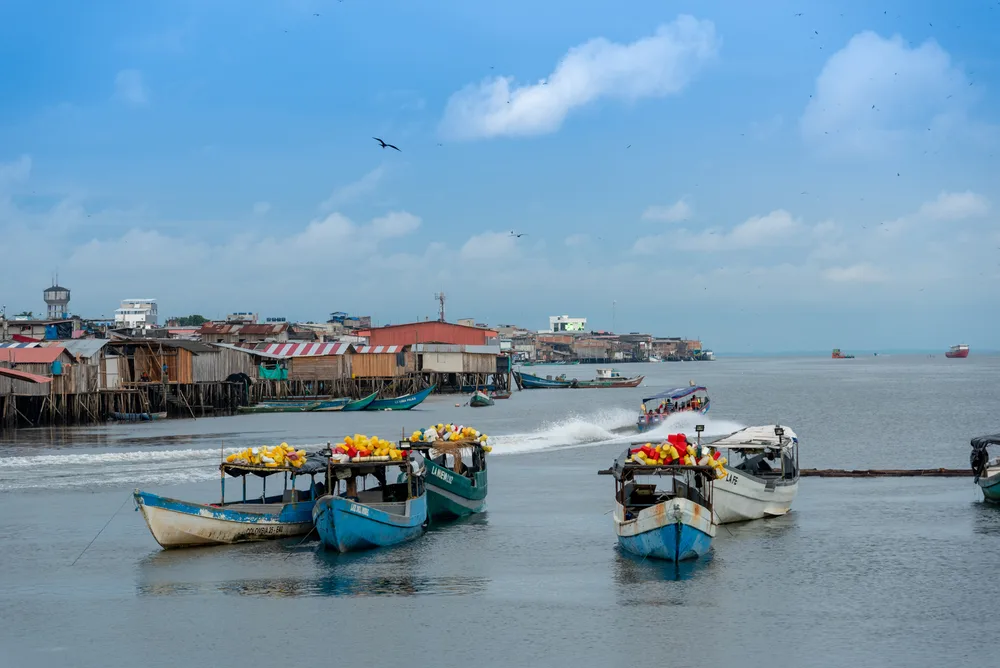
Boats with fishing nets at anchor in a fishing village on the Colombian Pacific coast. Tumaco, Nariño, Colombia. November 24, 2019/EGT-1/Shutterstock
Certain regions of Colombia should be avoided altogether due to the high risk of armed conflict and terrorism. These regions include:
- The Darien Gap region (on the border with Panama)
- Within 20 miles of the Venezuelan or Ecuadorian land borders
- Buenaventura
- Tumaco
- Arauca
- Cauca
- Choco (except some popular tourist areas)
- Norte de Santander
- Caqueta
- Putumayo
This is not an exhaustive list, and make sure that you check with locals when planning travel within Colombia. Colombia’s cities have certain neighborhoods that are dangerous. In Bogota, avoid La Candelaria, as it gets sketchy at night.
Parque Lleras in Medellin is a popular tourist hang-out, but also popular among criminals targeting tourists. When it comes to dangerous areas of the cities, trust your instincts. If a neighborhood feels sketchy, it probably is.
Things to Consider
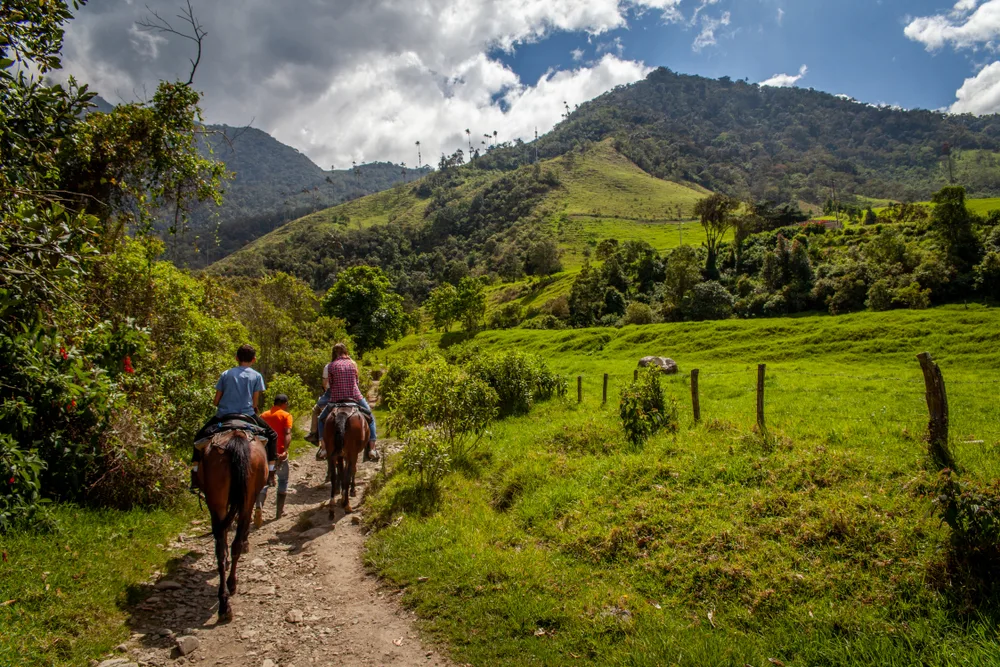
Enselme Arthur/Shutterstock
Here are a few additional safety tips for visiting Colombia:
- When going on treks or hikes, always go with a trained guide. A guide can help you navigate the often inhospitable terrain in rural Colombia, and prevent potential robberies and armed attacks that have targeted hikers in the past.
- Only use taxis that you book ahead of time, not taxis hailed on the street or local public transportation. Robbers often target taxi passengers or pose as taxi drivers.
- Be very careful with ayahuasca ceremonies. Consuming this plant is technically legal and people go on organized tours to consume it for spiritual reasons. However, there is limited research on its medical effects and some people suffer bad consequences. Some people also pose as ayahuasca tour operators to rob customers.
- Terrorist attacks are possible. Make sure that you follow the news and avoid areas that the government says are dangerous.
Frequently Asked Questions
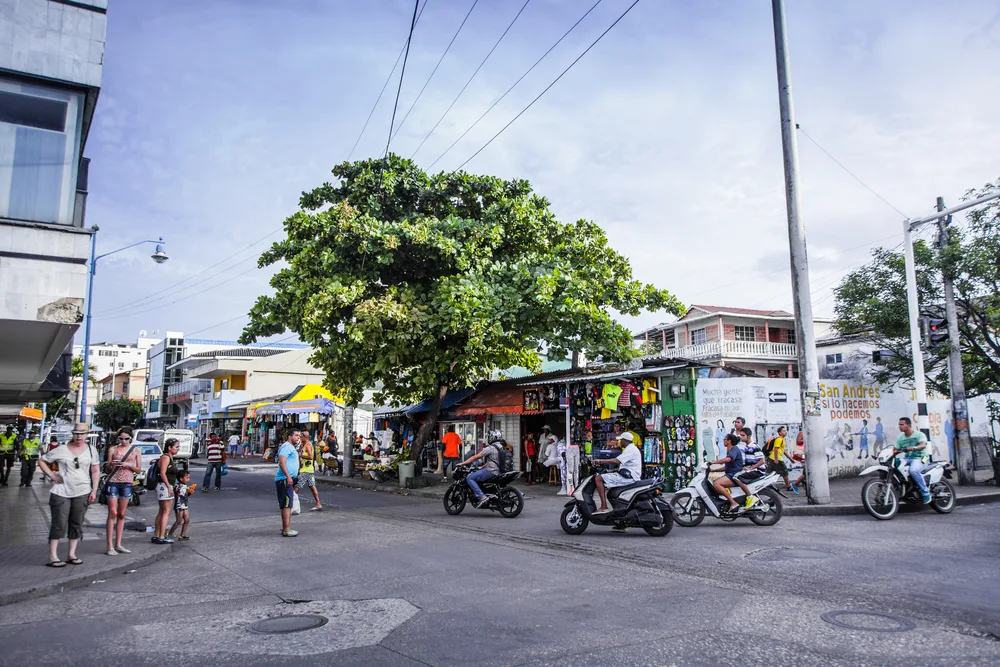
– San Andres, Colombia, January 7th 2014. Buzy Intersection with few tourists and lots of islanders. Motorcycle is the most popular vehicle then the Golf Cart is manly used by the tourists/Benoit Daoust/Shutterstock
Here are some common questions people ask about security in Colombia:
Are tourists safe in Colombia?
Tourists in Colombia are at risk of being the victims of crimes, just like locals. Tourists in Colombia have been robbed and even kidnapped before.
Is Colombia safer than Mexico?
Both Colombia and Mexico have very high crime rates and problems with drug trafficking. However, Mexico has certain areas that are very safe, while most parts of Colombia are fairly at risk, and there is a risk of armed conflict.
Is Colombia safe for a girls’ trip?
A group of any kind is safer than a solo traveler in Colombia. However, keep in mind that women in Colombia are at higher risk of certain crimes, such as assault.
Is Colombia Medellin safe?
Medellin is one of Colombia’s safest cities as it has one of the lowest crime rates. However, you should still take basic precautions to keep yourself safe.
Is Bogota or Medellin safer?
Medellin is generally safer than Bogota as it has a lower crime rate. Both cities have neighborhoods that are dangerous, so be careful wherever you go.
Should You Book a Trip to Colombia?
It’s hard to say that Colombia is a safe country due to the risk of violent crime, terrorism, and even armed conflict in some remote parts of the country.
However, it is possible to visit the country safely if you stick to safe areas, limit how much cash you carry, and visit remote areas only with a guide. Happy travels!






